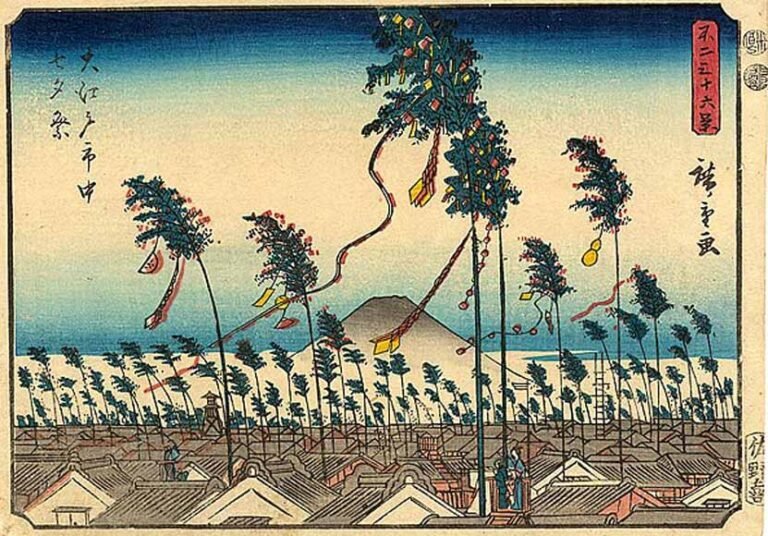Contenus
ToggleIn short
Tanabata (Japanese: たなばた or 七夕, meaning « Soir des septs), also known as the Star Festival (星祭り, Hoshimatsuri), is a Japanese festival originating from the Chinese Qixi Festival.

Tanabata, la rencontre de Orihime et Hikoboshi
Il célèbre la rencontre des divinités Orihime et Hikoboshi (représentées respectivement par les étoiles Vega et Altair). Selon la legend, la Voie lactée sépare ces amants et ils ne sont autorisés à se rencontrer qu’une fois par an le septième jour du septième mois lunaire du calendrier luni-solaire. La date de Tanabata varie selon les régions du pays, mais les premières festivités commencent le 7 juillet du calendrier grégorien. La célébration a lieu à différents jours entre juillet et août.
Comme Qixi et Chilseok, Tanabata s’est inspiré de la célèbre histoire du folklore Chinese, « Le vacher et la tisserande ». Certaines versions ont été incluses dans le Man’yōshū.
La version la plus populaire est la suivante :
Orihime (織姫, « Princesse Tisserande »), fille du Tentei (天帝, « Sky King », ou l’univers lui-même), a tissé de beaux vêtements au bord de l’Amanogawa (天の川, « Milky Way », littéralement « rivière céleste » ). Son père aimait le tissu qu’elle tissait et elle travaillait donc très dur chaque jour pour le tisser. Cependant, Orihime était triste qu’en raison de son travail acharné, elle ne puisse jamais rencontrer et tomber amoureuse de qui que ce soit.
Préoccupé par sa fille, Tentei s’est arrangé pour qu’elle rencontre Hikoboshi (彦星, « Cowman »/ »Cowherd Star », ou littéralement « Boy Star ») (également appelé Kengyū (牽牛)) qui vivait et travaillait de l’autre côté de les Amanogawa. Lorsque les deux se sont rencontrés, ils sont tombés instantanément amoureux l’un de l’autre et se sont mariés peu de temps après. Cependant, une fois marié, Orihime ne tisserait plus de tissu pour Tentei et Hikoboshi laissait ses vaches errer partout au paradis.
En colère, Tentei sépara les deux amants de l’autre côté de l’Amanogawa et leur interdit de se rencontrer. Orihime est devenue découragée par la perte de son mari et a demandé à son père de les laisser se revoir. Tentei a été ému par les larmes de sa fille et a permis aux deux de se rencontrer le 7ème jour du 7ème mois si elle travaillait dur et finissait son tissage. La première fois qu’ils ont essayé de se rencontrer, cependant, ils ont constaté qu’ils ne pouvaient pas traverser la rivière car il n’y avait pas de pont.
Orihime a tellement pleuré qu’un troupeau de pies est venu et a promis de faire un pont avec leurs ailes pour qu’elle puisse traverser la rivière. On dit que s’il pleut sur Tanabata, les pies ne peuvent pas venir à cause de la montée du fleuve et les deux amants doivent attendre une année de plus pour se rencontrer. La pluie de ce jour s’appelle « Les larmes d’Orihime et d’Hikoboshi ».
Le festival a été introduit au Japon par l’impératrice Kōken en 755. Il est issu du « Festival pour plaider pour les compétences » (乞巧奠, Kikkōden), un nom alternatif pour Qixi qui est célébré en Chine et a également été adopté en le palais impérial de Kyoto de la période Heian.
Le festival a gagné en popularité parmi le grand public au début de la période Edo, lorsqu’il s’est mélangé à diverses traditions Obon ou Bon (parce que Bon avait lieu le 15 du septième mois à l’époque), et s’est développé pour devenir le festival Tanabata moderne.
Les coutumes populaires relatives au festival variaient selon les régions du pays, mais généralement, les filles souhaitaient une meilleure couture et un meilleur savoir-faire, et les garçons souhaitaient une meilleure écriture en écrivant des souhaits sur des bandes de papier. A cette époque, la coutume était d’utiliser la rosée laissée sur les feuilles de taro pour créer l’encre utilisée pour écrire les souhaits. Incidemment, Bon a maintenant lieu le 15 août sur le calendrier solaire, proche de sa date d’origine sur le calendrier lunaire, ce qui fait que Tanabata et Bon sont des événements distincts.
Le nom Tanabata est lié à distance à la lecture Japanese des caractères chinois 七夕, qui étaient autrefois lus comme « Shichiseki » (voir l’explication sur les différentes lectures de kanji). On pense qu’une cérémonie de purification shinto existait à peu près à la même époque, au cours de laquelle un miko shinto a tissé un tissu spécial sur un métier à tisser appelé tanabata (棚機) et l’a offert à un dieu pour qu’il prie pour la protection des cultures de riz de la pluie ou de la tempête. pour une bonne récolte plus tard en automne.
Peu à peu, cette cérémonie a fusionné avec Kikkōden pour devenir Tanabata. Les caractères chinois 七夕 et la lecture japonaise Tanabata se sont joints pour signifier le même festival, bien qu’à l’origine ils aient été deux choses différentes, un exemple de jukujikun.
Social networks
Picture
